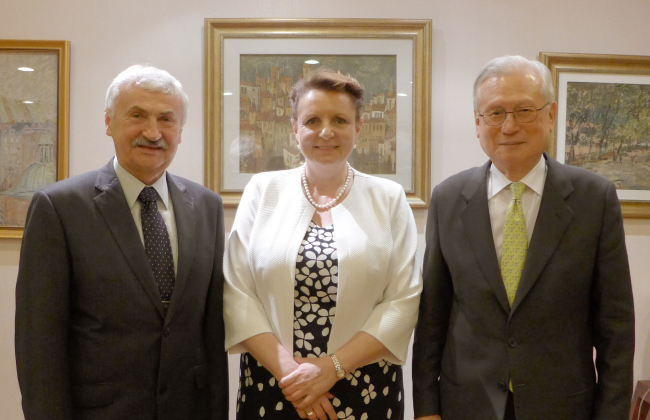Since establishing diplomatic ties in 1989, Poland and Korea have made great strides in bilateral relations that now extend into the heart of culture.
As both countries experienced colonial oppression and national independence, cultural sentiments find similar artistic expressions in society.
Polish Minister of Culture and Heritage Malgorzata Omilanowska visited Korea last week before the opening of the exhibition “Polish Art: An Enduring Spirit,” which runs at the National Museum of Korea June 5-Aug. 30.
The exhibition, which shows paintings, sculptures and decorative and applied art from the 15th to 20th century, is the largest ever of its kind outside of Poland.
On display are 250 original pieces by Jan Matejko, Jozef Brandt, Teofil Kwiatkowski and Stanislaw Wyspianski and Zofia Stryjenska, among others, collected from 19 museums and institutions from Poland.
 |
Polish Minister of Culture and Heritage Malgorzata Omilanowska (center) poses beside Polish Ambassador Krzysztof Ignacy Majka (left) and Synn Il-hi, president of Keimyung University and honorary consul general of Poland to Korea, at a reception at the ambassador’s residence in Seoul on Saturday. (Joel Lee/The Korea Herald) |
The National Museum of Korea, Korea Broadcasting System, the National Museum in Warsaw and the Adam Mickiewicz Institute collaborated.
“Although I am not an art expert, I can say that the exhibition is a time capsule of Polish art intermingling with our history,” Polish Ambassador Krzysztof Ignacy Majka said in a reception at the ambassador’s residence in Seoul on Saturday.
Quoting Brazilian novelist Paulo Coelho, the ambassador added: “Culture allows people to understand each other. And if they can do that through their souls, they can overcome economic and political barriers. We get to understand that our neighbors are just like us, with the same problems and questions.”
Omilanowska said the purpose of her visit was to recognize from the Korean side what the Polish government should do to promote mutual cultures to each other. This exhibition will serve as a stepping stone for a new level of bilateral collaboration, she noted.
The minister met her Korean counterparts in the Ministry of Culture, Sports and Tourism, as the two governments are working on agreements in culture, science, education and youth.
“Art represents our thoughts and mirrors our experience. Poland was only able to survive foreign invasions by preserving our culture,” Omilanowska told The Korea Herald. “In a state of state absence, language and culture are the only tools that keep people together.”
Omilanowska said that Poland, having established Europe’s first democratic constitution in 1791, developed toward a democratic direction too quickly. Having a strong democracy without a strong military, the imperial neighbors of Russia and Germany invaded Poland and stripped it of its sovereignty for over 120 years.
A part of the exhibition shows growing nationalist sentiments in the works of artists from the early 20th century onward, who tried to recapture Polish identity, culture and language.
The highlight painting “Batory at Pskov (1872)” by Jan Matejko shows a defeated Russian monarch kneeling in humiliation before Polish King Stefan Batory in the siege of Pskov, which took place in 1581 and 1582.
These late 19th-century art productions tried to capture the greatest moments in Polish history and supported the independence cause, she highlighted.
During the first era of communism from 1945 to 1956, the Soviet authorities pressed artists to produce works of socialist realism that glorified the communist ideology -― laborers sweating and working in factories happily, farmers toiling the lands with sickles and people chanting and demonstrating socialist slogans.
However, after 1956 and the death of Joseph Stalin, Polish art recaptured more diverse, free-spirited, European perspectives through abstract, modern and non-figurative paintings.
“It was my first time visiting Korea, but the positive experience I have made overwhelmed my previous expectations of Korea. Now I feel that we are much nearer despite our physical distance,” Omilanowska said.
“I could sympathize with Korea’s situation after I visited the demilitarized zone. Poland is similarly experiencing military tensions with Russia along our border.”
The Polish government tries to find countries where representing Polish culture would create a framework for exchange in diplomacy, economy and technology, Omilanowska explained.
Poland has highly advanced creative industries with innovation in software contents and engineering, according to the minister.
Omilanowska mentioned the action role-playing video game “The Witcher” ― based on medieval fantasy by Polish novelist Andrzej Sapkowski ― as a leading example of industry collaboration in Poland.
The Academy of Fine Arts in Warsaw specializes in and promotes new media and filmmaking, which has contributed to Polish films sweeping international awards.
The Korean Cultural Center in Warsaw and Korean language faculties at Polish universities have also elevated Polish people’s understanding and curiosity of Korean culture.
Translation of literature into each other’s language must also be encouraged strongly, she said.
By Joel Lee (
joel@heraldcorp.com)








